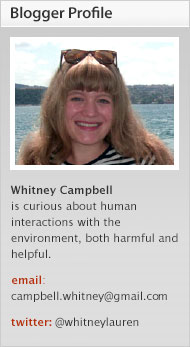« Prev Next »

In her current position, Abby has continued her environmental vocation by researching and implementing policies that seek to balance the needs of stakeholders and ecosystems with logistical and economic considerations. In the following Q & A, Abby shares some insight into this work at the EPA, with this post being the first of a series called Greener Worlds that will feature conversations with specialists concerned with complex ecologies.
When did you first become interested in environmental issues and why do you think the environment deserves attention? How has working at the EPA allowed you to pursue those concerns?
I first became interested in environmental issues in college. Stanford had a bunch of opportunities to get involved in everything from dining hall waste issues to urban agriculture and direct action to save the redwoods. I got really excited about community agriculture, and when I was doing my thesis research on a Parks Department-run program in Portland, Oregon, I realized that what I was most passionate about was seeing more and better green spaces in cities. We know that compact cities are good for the environment in terms of protecting open space and farmland, limiting impervious surfaces that create water quality issues, and reducing the distances people have to drive. But people living in these dense cities need green spaces to relax and play too. The work I do with EPA's Office of Sustainable Communities lets me pursue that very issue, particularly through our assistance programs to communities all over the country. The best example is probably our Greening America's Capitals program, where we work with state capital cities to find new designs for existing public spaces that can work better for the environment and the people who use these public spaces. We helped plan to revitalize a creek in Jefferson City, Missouri, and worked with Boston to redesign City Hall Plaza in a way that would include more trees to block wind, add shade, and manage stormwater.
Stormwater management is such an important aspect of urban design. In those projects with the EPA's Office of Sustainable Communities, it sounds like you may have been able to draw on your work in the agency's Office of Water. How do these departments compare, in terms of the kinds of initiatives you are working on and their relationships to the public?
In both offices I have the chance to work directly with communities, and good planning always includes a fair, predictable, and transparent process. So we often hold public meetings and open house events with the public about whatever project we're working on, whether it's to talk about using more green infrastructure to manage stormwater or trying to integrate green building practices into historic buildings.
What has been your favorite initiative or policy you've been involved in?
The project I'm most excited about right now is our partnership with FEMA to help communities recover from disasters and better plan for future risks. This work is an intersection of several existing fields, including land use planning, climate change science, and emergency management. We did several projects in Iowa following the floods and tornadoes they experienced there in 2008, and it was heartening to see these different fields come together to find better long-term ways to rebuild after a disaster so that the community gets towards their future goals for what they want their community to be. A natural disaster like a flood can be devastating to a community, but the recovery process provides an incredible opportunity to better plan for the future, including consideration of climate change.
Do you have any advice for aspiring professional environmentalists?
Think about what you're excited about working on, but also think about what your own strengths are and how the two come together. I worked for an advocacy non-profit right out of college, and as I was standing on a corner trying to get strangers to sign petitions or take flyers, I realized that I wasn't made to do that type of environmental work. I finally settled in a job that lets me balance my interests in policy issues with my desire to work directly with communities on real projects.
So glad you did. And thank you for chatting about it with Green Screen!






















